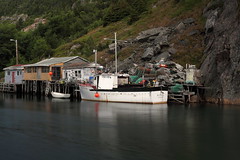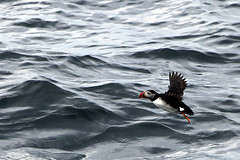First stop of the day was Quidi Vidi, a small fishing community in St. Johns. Apparently it's one of the most photographed locations in Newfoundland.
The narrow and winding streets make you feel like you're in another world. Pretty houses and a lovely cove......and a Brewery. What more could you want?!

Next I wanted to see the Witless Bay Ecological Reserve so we decided on O'Briens Whale & Bird Tours. It was a good decision and seems to be the tour company of choice for the locals.
We boarded one of their 46-foot vessels and because of the photo equipment, I was told the best spot to sit was the top deck of the boat on the left side so I'd be closest to the Island and would get a good view. Our guide Michael was amazing navigating the rough ocean and went out of his way to provide me with as many photo opportunities as possible. I found it extremely difficult to get any shots that I liked because I couldn't figure out how to hold onto the boat and the camera at the same time without slipping or being thrown into the air a foot or two! So this is the best I could do :)
Witless Bay Ecological Reserve is North America's largest Atlantic puffin colony. More than 260,000 pairs nest there during the late spring and summer. Overall about 95% of all North America's puffins breed around the Newfoundland and Labrador coasts.
The Atlantic puffin is a member of the auk family and is related to the razorbill, dovekie, black guillemot, common murre and thick billed murre. They are much smaller than I expected, standing a foot tall at the most. They pair for life and each year they use the same nesting burrow to lay a single egg. Newfoundland is the main breeding area for this species in North America.
The Witless Bay Ecological Reserve contains four islands: Gull, Green, Great, and Pee Pee. This area also hosts the second-largest Leach's storm-petrel colony in the world (more than 620,000 pairs nest there). In addition, black-legged kittiwakes and common murres appear in the thousands.
Seabirds generally spend most of the year at sea and only return to land from May to August to breed and raise their young. For the most part, you can only view them by boat.....landing on the islands themselves requires a scientific research or special access permit.
Then he took us about 4 miles towards Ferryland to see two Humpbacks. The waves were about two metres high and it made for a very interesting trip! We got to the Whales and they were spouting and we saw one of them do a terminal dive and show his fluke. I was so interested in the experience that I actually forgot to photograph it!






No comments:
Post a Comment